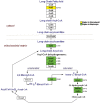Differential expression of lipid and carbohydrate metabolism genes in upper airway versus diaphragm muscle
- PMID: 20337195
- PMCID: PMC2831431
- DOI: 10.1093/sleep/33.3.363
Differential expression of lipid and carbohydrate metabolism genes in upper airway versus diaphragm muscle
Abstract
Study objectives: Contractile properties of upper airway muscles influence upper airway patency, an issue of particular importance for subjects with obstructive sleep apnea. Expression of genes related to cellular energetics is, in turn, critical for the maintenance of contractile integrity over time during repetitive activation. We tested the hypothesis that sternohyoid has lower expression of genes related to lipid and carbohydrate energetic pathways than the diaphragm.
Methods: Sternohyoid and diaphragm from normal adult rats were examined with gene expression arrays. Analysis focused on genes belonging to Gene Ontology (GO) groups carbohydrate metabolism and lipid metabolism.
Results: There were 433 genes with at least +/- 2-fold significant differential expression between sternohyoid and diaphragm, of which 192 had sternohyoid > diaphragm and 241 had diaphragm > sternohyoid expression. Among genes with higher sternohyoid expression, there was over-representation of the GO group carbohydrate metabolism (P = 0.0053, n = 13 genes, range of differential expression 2.1- to 6.2-fold) but not lipid metabolism (P = 0.44). Conversely, among genes with higher diaphragm expression, there was over-representation of the GO group lipid metabolism (P = 0.0000065, n = 32 genes, range of differential expression 2.0- to 37.9-fold) but not carbohydrate metabolism (P = 0.23). Nineteen genes with diaphragm > sternohyoid expression were related to fatty acid metabolism (P = 0.000000058), in particular fatty acid beta oxidation and biosynthesis in the mitochondria.
Conclusions: Sternohyoid has much lower gene expression than diaphragm for mitochondrial enzymes that participate in fatty acid oxidation and biosynthesis. This likely contributes to the lower fatigue resistance of pharyngeal upper airway muscles compared with the diaphragm.
Figures





Similar articles
-
Gene expression of sternohyoid and diaphragm muscles in type 2 diabetic rats.BMC Endocr Disord. 2013 Oct 7;13:43. doi: 10.1186/1472-6823-13-43. BMC Endocr Disord. 2013. PMID: 24199937 Free PMC article.
-
Contrast between cardiac left ventricle and diaphragm muscle in expression of genes involved in carbohydrate and lipid metabolism.Respir Physiol Neurobiol. 2008 Mar 20;161(1):41-53. doi: 10.1016/j.resp.2007.11.005. Epub 2007 Dec 4. Respir Physiol Neurobiol. 2008. PMID: 18207466
-
Effects of genetic obesity on rat upper airway muscle and diaphragm contractile properties.Eur Respir J. 1996 Oct;9(10):2139-44. Eur Respir J. 1996. PMID: 8902480
-
Effect of lipid oxidation on glucose utilization in humans.Am J Clin Nutr. 1998 Mar;67(3 Suppl):527S-530S. doi: 10.1093/ajcn/67.3.527S. Am J Clin Nutr. 1998. PMID: 9497164 Review.
-
Metabolic interactions between glucose and fatty acids in humans.Am J Clin Nutr. 1998 Mar;67(3 Suppl):519S-526S. doi: 10.1093/ajcn/67.3.519S. Am J Clin Nutr. 1998. PMID: 9497163 Review.
Cited by
-
Mechanical properties of respiratory muscles.Compr Physiol. 2013 Oct;3(4):1553-67. doi: 10.1002/cphy.c130003. Compr Physiol. 2013. PMID: 24265238 Free PMC article. Review.
-
Gene expression of sternohyoid and diaphragm muscles in type 2 diabetic rats.BMC Endocr Disord. 2013 Oct 7;13:43. doi: 10.1186/1472-6823-13-43. BMC Endocr Disord. 2013. PMID: 24199937 Free PMC article.
-
Understanding Pathophysiological Concepts Leading to Obstructive Apnea.Obes Surg. 2018 Aug;28(8):2560-2571. doi: 10.1007/s11695-018-3325-6. Obes Surg. 2018. PMID: 29948871 Review.
-
Diaphragm Muscle Adaptation to Sustained Hypoxia: Lessons from Animal Models with Relevance to High Altitude and Chronic Respiratory Diseases.Front Physiol. 2016 Dec 12;7:623. doi: 10.3389/fphys.2016.00623. eCollection 2016. Front Physiol. 2016. PMID: 28018247 Free PMC article. Review.
References
-
- Young T, Palta M, Dempsey J, Skatrud J, Weber S, Badr S. The occurrence of sleep-disordered breathing among middle-aged adults. New Engl J Med. 1993;32:1230–5. - PubMed
-
- Flemons WW, Tsai W. Quality of life consequences of sleep-disordered breathing. J Allergy Clin Immunol. 1997;99:S750–6. - PubMed
-
- Peppard P, Young T, Palta M, Skatrud J. Prospective study of the association between sleep disordered breathing and hypertension. N Engl J Med. 2000;342:1378–84. - PubMed
-
- Teran-Santos J, Jimenez-Gomez A, Cordero-Guevara J, Cooperative Group Burgos-Santander The association between sleep apnea and the risk of traffic accidents. N Engl J Med. 1999;340:847–51. - PubMed
-
- Haponik E, Smith P, Bohlman M, Allan R, Goldman S, and Bleecker E. Computerized tomography in obstructive sleep apnea: correlation of airway size with physiology during sleep and wakefulness. Am Rev Respir Dis. 1983;127:221–6. - PubMed
Publication types
MeSH terms
Substances
LinkOut - more resources
Full Text Sources
Medical
Molecular Biology Databases

